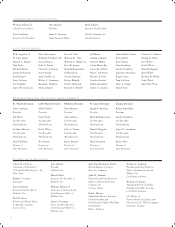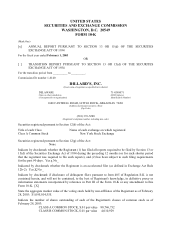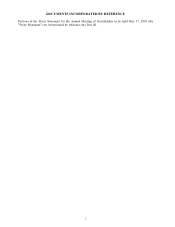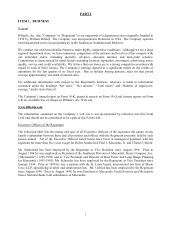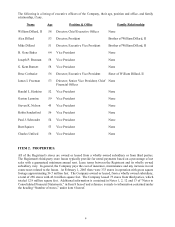Dillard's 2002 Annual Report Download - page 14
Download and view the complete annual report
Please find page 14 of the 2002 Dillard's annual report below. You can navigate through the pages in the report by either clicking on the pages listed below, or by using the keyword search tool below to find specific information within the annual report.these reporting units was estimated using the expected discounted future cash flows and market values of related
businesses, where appropriate. The cumulative effect of the accounting change as of February 3, 2002 was to
decrease net income for fiscal year 2002 by $530 million or $6.22 per diluted share.
Effective January 30, 2000, the Company changed its method of accounting for inventories under the retail inventory
method. The change principally relates to the Company’s accounting for vendor markdown allowances, from
recording these allowances directly as a reduction of cost of sales to recording such allowances as a reduction of
inventoriable product cost. The cumulative effect of the accounting change as of January 30, 2000 was to decrease
net income for fiscal year 2000 by $130 million, net of tax, or $1.42 per share. The effect of adopting the new
method was to increase both income before extraordinary item and net income for fiscal 2000 in the amount of $30
million ($.33 per share).
Critical Accounting Policies and Estimates
The Company’s accounting policies are more fully described in Note 1of Notes to Consolidated Financial Statements.
As disclosed in Note 1 of Notes to Consolidated Financial Statements, the preparation of financial statements in
conformity with accounting principles generally accepted in the United States of America (“GAAP”) requires
management to make estimates and assumptions about future events that affect the amounts reported in the
consolidated financial statements and accompanying notes. Since future events and their effects cannot be determined
with absolute certainty, actual results will differ from those estimates. The Company evaluates its estimates and
judgments on an ongoing basis and predicates those estimates and judgments on historical experience and on various
other factors that are believed to be reasonable under the circumstances. Actual results will differ from these under
different assumptions or conditions.
Management of the Company believes the following critical accounting policies, among others, affect its more
significant judgments and estimates used in preparation of the Consolidated Financial Statements.
Merchandise inventory. Approximately 97% of the inventories are valued at lower of cost or market using the retail
last-in, first-out (“LIFO”) inventory method. Under the retail inventory method (“RIM”), the valuation of inventories
at cost and the resulting gross margins are calculated by applying a calculated cost to retail ratio to the retail value of
inventories. RIM is an averaging method that has been widely used in the retail industry due to its practicality.
Additionally, it is recognized that the use of RIM will result in valuing inventories at the lower of cost or market if
markdowns are currently taken as a reduction of the retail value of inventories. Inherent in the RIM calculation are
certain significant management judgments including, among others, merchandise markon, markups, and markdowns,
which significantly impact the ending inventory valuation at cost as well as the resulting gross margins. Management
believes that the Company’s RIM provides an inventory valuation which results in a carrying value at the lower of
cost or market. The remaining 3% of the inventories are valued at lower of cost or market using the specific identified
cost method.
Allowance for doubtful accounts. The accounts receivable from the Company’s proprietary credit card sales are
subject to credit losses. The Company maintains allowances for uncollectible accounts for estimated losses resulting
from the inability of its customers to make required payments. The adequacy of the allowance is based on historical
experience with similar customers including bankruptcy and write-off trends, current aging information and year-end
balances. Management believes that the allowance for uncollectible accounts is adequate to cover anticipated losses
in the reported credit card receivable portfolio under current conditions; however, significant deterioration in any of
the above-noted factors or in the overall health of the economy could materially change these expectations.
Vendor Allowances. The Company receives concessions from its vendors through a variety of programs and
arrangements, including co-operative advertising and markdown reimbursement programs. Co-operative
advertising allowances are reported as a reduction of advertising expense in the period in which the advertising
occurred. All other vendor allowances are recognized as a reduction of cost purchases. Accordingly, a reduction or
increase in vendor concessions has an inverse impact on cost of sales and/or selling and administrative expenses.
The FASB’s EITF Issue 02-16, “Accounting By A Customer (Including A Reseller) For Cash Consideration
Received From A Vendor” addressed the accounting treatment for vendor allowances. The Company has not
completed the process of evaluating the impact of EITF Issue 02-16; however, the Company does not expect that its
adoption in 2003 will have a material impact on its financial position or results of operations.
Self insurance accruals. The Company purchases third-party insurance for workers’ compensation, automobile,
product and general liability claims that exceed a certain level. However, the Company is responsible for the payment
of claims under these insured limits. In estimating the obligation associated with incurred losses, the Company
utilizes loss development factors. These development factors utilize historical data to project the future development
of incurred losses. Loss estimates are adjusted based upon actual claims settlements and reported claims.
8




